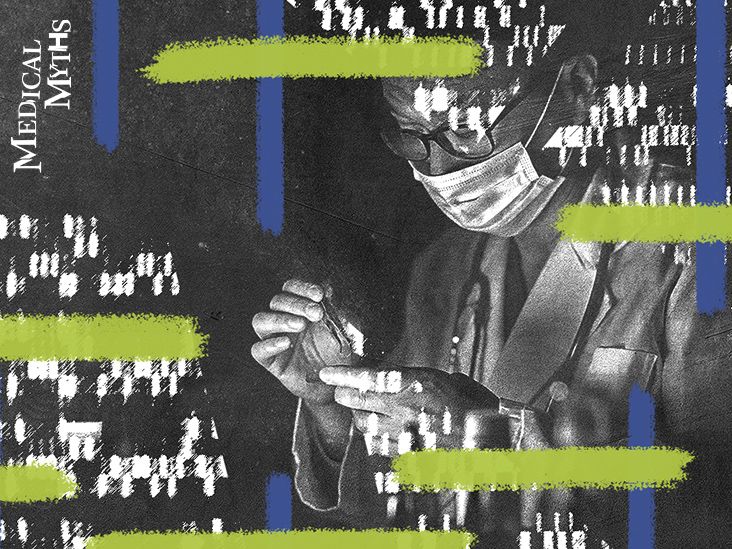
According to the Centers for Disease Control and Prevention (CDC), epilepsy affects an estimated
Globally, the
The primary symptom for most people with epilepsy is seizures. These are surges of electrical activity in the brain. Where in the brain these seizures occur can alter how they affect the rest of the body.
Beyond managing seizures, people with epilepsy often have to deal with stigma. As the authors of one study write:
“The stigmatizing nature of epilepsy and its associated psychological distress have been reported to have a significant impact on the quality of life of individuals with epilepsy.”
One way of reducing stigma is to arm people with the facts about epilepsy. Below, we tackle 13 epilepsy myths. To help us, we have recruited the insight of Dr. Clifford Segil, a neurologist at Providence Saint John’s Health Center in Santa Monica, CA.
Although epilepsy is probably the most well-known seizure condition, it is not the only one. Epilepsy is caused by abnormal electrical activity in the brain, whereas other conditions may have different mechanisms.
For instance, low blood sugar or problems with the way the heart functions can cause non-epileptic seizures.
The most common form of non-epileptic seizures is dissociative seizures, or psychogenic non-epileptic seizures (PNES).
PNES have an association with a range of factors, including mental health conditions and psychological trauma. It is worth noting that an estimated
This is a myth. As Dr. Segil told Medical News Today, people with epilepsy or who have seizures “can work when their seizures are controlled by medicine.”
He also told us that he has “known fellow physicians with epilepsy.”
“There are only a few instances where having a seizure disorder disqualifies people from working, and these include being a pilot and truck driver.”
This is an old myth that is still prevalent, particularly in some parts of the world, but it has no basis in fact — epilepsy is not contagious.
However, although experts know that epilepsy cannot transmit from person to person, identifying the cause is challenging. According to the
The following are some of the potential causes of epilepsy:
- brain damage that occurred during or just after birth
- brain malformation with genetic origins
- severe head injuries
- stroke
- brain infections, such as meningitis or encephalitis
- some genetic syndromes
- brain tumors
There is a significant amount of stigma attached to epilepsy. Part of this stigma includes the theory that people with the condition are more likely to be “emotionally unstable.” This is not true.
“Patients with epilepsy are not emotionally unstable,” Dr. Segil told MNT.
“It is unsettling to have a seizure disorder and know a seizure can strike any time, but most epilepsy patients are happy [and] most epilepsy cases are easily controlled using monotherapy, or one seizure medication.”
Related to the myth above, this is also untrue — epilepsy is not a mental illness. As the Epilepsy Foundation writes:
“[T]he vast majority of people living with epilepsy have no cognitive or psychological problems. For the most part, psychological issues in epilepsy are limited to people with severe and uncontrolled epilepsy.”
Not everyone with epilepsy loses consciousness and convulses during a seizure. According to the Epilepsy Society:
“Not all seizures involve jerking or shaking movements. […] There are over 40 different types of seizures. What seizures look like can vary. For example, someone may go ‘blank’ for a couple of seconds, [or] they may wander around and be quite confused.”
This is a dangerous myth. As the
This is another common myth. “Most seizures last for 30–90 seconds, and there is no reason to restrain a patient with a seizure,” explained Dr. Segil.
“A hallmark symptom of an epileptiform seizure is that it is not suppressible, which means they don’t stop when you hold a person down.”
However, he explained that it “is reasonable to lay someone on their side.” He also suggested that filming the seizure with a cell phone might help a doctor modify the individual’s seizure care.
Pain during a seizure, or ictal pain, is rare. In one
However, some people might experience pain after a seizure. This may be due to a fall or injury during the seizure or because of prolonged muscle contractions.
Some people can experience a headache before, during, or after a seizure.
Only people with photosensitive epilepsy are at risk of seizure when viewing strobing lights.
Photosensitive epilepsy accounts for just 5% of epilepsy cases. For these people, it is not only strobe lighting that can trigger a seizure. Other visual stimuli, such as moving patterns and shapes, may also trigger them.
Although this is not true, Dr. Segil explained to MNT that doctors consider pregnancies in people with seizures high risk. This means that they will see their obstetrician a few more times than people without a seizure disorder.
“They are also followed more closely by their neurologists during this period,” he explained.
“Some seizure medications are not safe to be used while pregnant, but in 2021 there are many more medications that are safe for both the mother and developing baby.”
This is a myth that extends beyond epilepsy. In fact, it is not possible to swallow one’s tongue under any circumstances.
During a seizure, however, it is
Thankfully, this is another myth. There is no cure for epilepsy, but a range of treatments are available to help.
For many people, anti-epileptic drugs successfully prevent seizures. According to the Epilepsy Society, an estimated 7 in 10 people with epilepsy could stop having seizures once they are on the right medication.
For individuals who do not respond to drugs, other options include surgery, vagus nerve stimulation, and even
As scientists continue to study, they move ever closer to a cure for epilepsy. Although it may be some time away, the work is ongoing.
Find information on first aid for seizures here.



